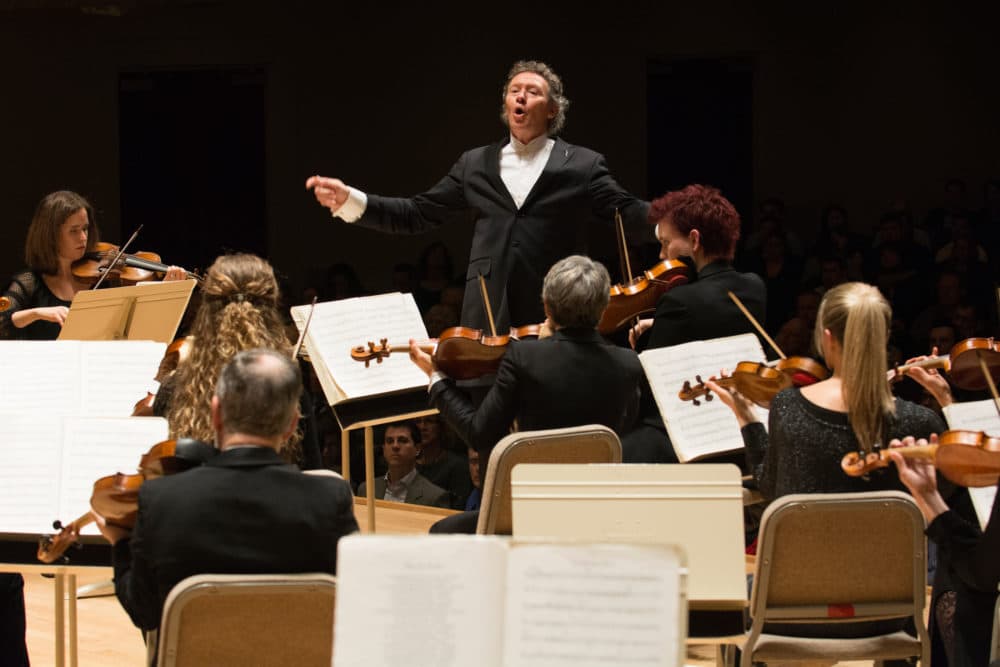Advertisement
Handel & Haydn Elevate Purcell's 'Dido And Aeneas' Beyond A Typical Concert Experience

Semi-staged opera lives in a half-world — part orchestral concert, part dramatic presentation. The goal is straightforward: to involve the audience in a dramatic narrative. The challenge? Do that with only subtle gestures and movement; there's no costuming, and certainly no sets. The focus is on the music.
"We call it enhancing," says Aidan Lang, who directs the Handel & Haydn Society’s upcoming presentation of Purcell’s "Dido and Aeneas." "It is a concert first off, but we try to move people away from the concert experience."
"Dido and Aeneas" is Purcell's only true opera, and one of the earliest known English operas. It tells the story of doomed love and devotion to duty. Lang, who recently announced he’s leaving the directorship of Seattle Opera for a similar position with the Welsh National Opera, is teaming up with Handel & Haydn's music director Harry Christophers to present it at Jordan Hall on March 29 and 31.
Lang and Christophers have put on "Dido and Aeneas" several times together already, and also semi-staged productions of Purcell’s "The Fairy-Queen," Handel’s "Samson" and other Baroque operas.
“We strive for active engagement with the audience,” Christophers says. “Any acting is minimal.”
Lang and Christophers try to walk the line between focusing on the music and bringing the story of doomed love to life visually.
That proves tricky as the stage is filled with instrumentalists.
“Sitting and listening to an orchestra is fundamentally a static image,” Lang says. “As soon as you flip that around, even slightly, the audience shifts their focus. In a production like this, the orchestra has an active relationship with the audience, not a passive one.”
Lang couldn’t be more correct. Instrumentalists who are surrounded by singers in character, using even the most modest gestures, become actors themselves.
Nods, glances, hand gestures, small movements on the the stage — every single action brings the audience into a world that has long since past, but whose story remains relevant.
“We’re reimagining it,” Lang says, “so that people find a connection, so they find the universal truths that move from era to era.”
Mezzo Susan Bickley sings Dido, and baritone David McFerrin her duty-bound lover Aeneas. Sailors and witches round out the cast — Purcell inserted a "Macbeth"-like twist to the story, with a pair of sorceresses to help drive the plot. Bass-baritone Matthew Brook, countertenor Reginald Mobley, and sopranos Sarah Yanovitch, Sonja DuToit Tengblad, Margot Rood and Sarah Brailey round out the cast. They’ll recreate the story of the queen of Carthage, welcoming the wandering warrior to her court, then falling in love with disastrous consequences.
Advertisement
“At the heart of it is the story of Dido and Aeneas, of love and duty,” Lang says. “With her dalliance in love, her kingdom is suffering. Just as Aeneas has a sense of duty, she does as well. And she’s taking leave of her people.”
As both directors point out, the physical gestures are meant to aid the music — not replace it, or overwhelm it. The strength of the score, and the idiosyncratic brilliance of Purcell’s text-settings, are the real core.
“Purcell is quintessential English,” Christophers says. “He’s a Londoner through and through. He wrote so much music with that English quirkiness. He had great insight into the personalities he wrote for, and he really gets the text. No English composer wrote for the English language like Purcell.”
Extensive experience staging Baroque operas has taught Christophers more about bringing the music to life.
“We all knew Purcell was good, but we didn’t know why,” he says. The resurgence in popularity of early opera, and the increased number of performances worldwide, have offered insights into the music.
“Purcell has benefited from the early-music movement, from repeated performances,” he says. “We had to play his music in order to stop making little corrections to it.”
The practice of correcting a score may seem strange — but in the less precise world of Baroque notation, the idea that the musicians simply play the notes in front of them is hardly true. Possibilities for interpretation are everywhere.
“We now believe in Purcell’s rhythms, we don’t try to iron everything out,” Christophers says. “The continuo players have free license to improvise — I tell them, ‘You’ve got to go further to make total sense of it.’ ”
Making sense of the sweeping tale in the intimate confines of Jordan Hall, with limited action, no costumes or props — this might feel like a burden for some directors, but Lang embraces it. Having the audience close to the action approximates contemporary concert-going experiences.
“In Jordan Hall you can make it a rock concert with Baroque music,” Lang says. “You can give it sharpness, and focus the audience, move them out of their comfort zone.”
Out of a comfort zone perhaps, but neither the musicians nor the audience are ever far from the directness of Purcell’s message.
“The singers are not clutching a score,” Lang says. “There’s nothing in the way. They’re trying to speak to people today, not just about a piece of the past.”
The Handel & Haydn Society performs Purcell’s opera "Dido and Aeneas" on March 29 and 31 at New England Conservatory’s Jordan Hall. H&H performs the same program March 30 in the Temple of Dendur at New York’s Metropolitan Museum.